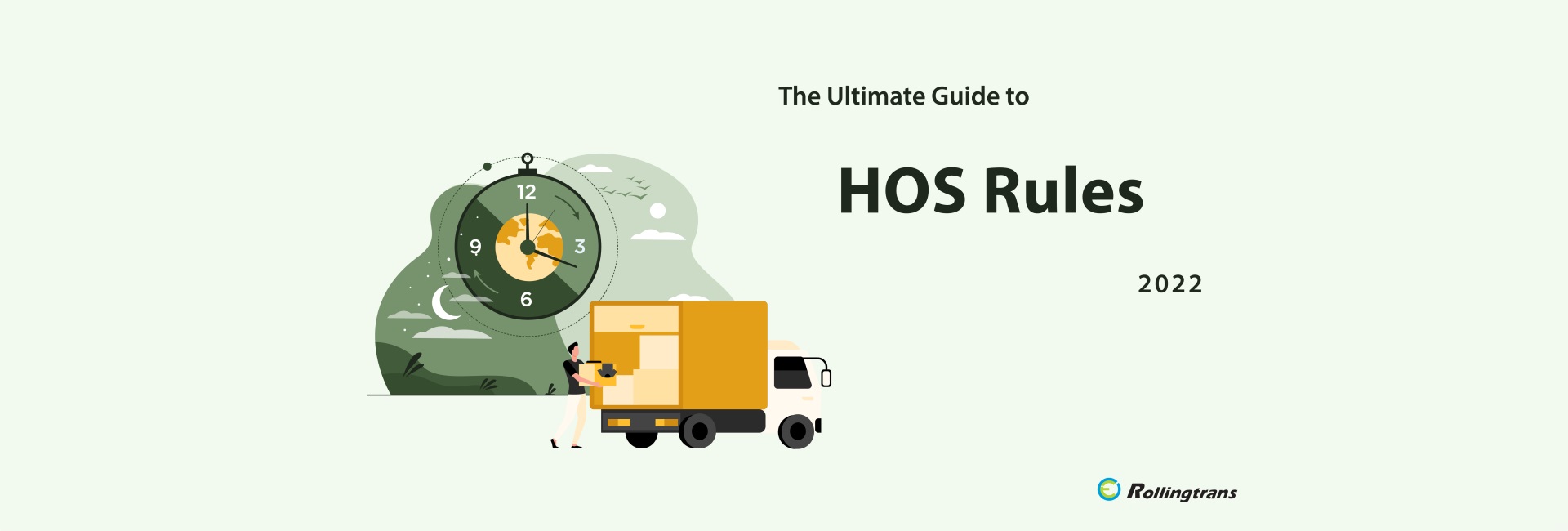
ELD Regulations
The Ultimate Guide to HOS Regulations 2022
Having a hard time understanding HOS regulations? Rollingtrans is here to help! In this article, we will thoroughly explain each rule in HOS regulations to help you stay compliant on the road.
What Is HOS?
HOS stands for Hours of Service. The Federal Motor Carrier Safety Administration (FMCSA) applies the HOS rules to regulate the maximum amount of time a commercial motor vehicle (CMV) driver can drive, work, or rest within a certain time period. It helps drivers stay safe on the road and protects other vehicles at the same time. There are 4 main rules and 3 main exemptions in HOS regulations. On Dec. 17, 2017, the mandate has become effective.
4 Main HOS Rules
1. 14-Hour Limit
The rule regulates a certain off work time point for drivers. When a driver starts working, they need to finish the work within a certain hours range. For property carrying drivers, they have a 14-hour limit, while for passenger-carrying drivers, they have a 15-hour limit. For example, if a property-carrying driver starts work at 8 am, he needs to end the job before 10 pm or they’ll violate the regulation. Be aware, once you start to do the DVIR, you are starting to work on-duty.
2. 11-Hour Driving Limit
The rule regulates the maximum hours drivers can drive per cycle. For property-carrying drivers, they have accumulated 11 driving hours within the 14-hour working limit, while for passenger-carrying drivers, they have accumulated 10 driving hours within the 15-hour working limit.
3. 30-Minute Driving Break
The rule regulates when a driver should take a break. Property-carrying drivers must take at least a 30-minute consecutive break when they have driven for 8 cumulative hours. That is, drivers can’t drive more than 8 hours consecutively. The break can be taken in on-duty not driving status, off-duty status, sleeper berth, or any combination of these.
4. 60/70-Hour Limit
Drivers can only drive to a maximum 60 hours in 7 consecutive days or a maximum 70 hours in 8 consecutive days. The loop will continue day after day. To fully restart a new cycle, a driver needs to take 34 or more consecutive rest, including off-duty and sleeper berth.
Here’s an example to help you better understand the rule. We will use 70 hours per 8 days in the example. Consider that a driver has taken 34 hours consecutive off-work rest. He starts a brand new 60/70 hour cycle on Sep 1. From Sep 1 to Sep 7, he drives 10 hours each day. Then, based on the 60/70 hour rule, how many hours can he still drive on Sep 8? The answer is 0, because he has already used up the whole 70 hours in the first 7 days. If he only drives 9 hours each day in the first 7 days, he will have 7 hours left on Sep 8. It’s a simple math: 70 hours minus 9 hours times 7 days. If he drives 8 hours each day for the first 7 days, he will have 14 hours left on Sep 8, but he can only drive up to 11 hours in order not to break the second rule, Driving Hour Limit.
Then, how about Sep 9? How many hours can the driver drive on Sep 9? Let’s reuse the second situation above that the driver drives 9 hours from Sep 1 to Sep 7. He has 7 hours left on Sep 8. We assume he doesn’t use up the whole 7 hours. He only drives 6 hours. Then, he will have 10 hours left on Sep 9 because the 60/70 hours window moves from Sep 1 to Sep 2. Within Sep 2 to Sep 9 these 8 days, he has a total of 70 driving hours. The window moves every day and the loop keeps continuing. If the driver wants to start a brand new 60/70 hours cycle, not just simply moves the cycle window, he needs to take at least 34 hours consecutive hours off-work rest.
3 Main HOS Exemptions
1. Short Haul Exception
Drivers who meet all the following requirements are exempted from the HOS regulations: A. Drivers operate within a 150* air-mile radius of their normal work reporting location, as well as begin and end the workday at the same location. 150 air-mile radius equals 172.6 miles. B. Drivers do not exceed the 14 consecutive working hours, and take at least ten consecutive hours off-duty between each work shift. Companies should keep drivers’ time records for a minimum of six months.
2. Adverse Driving Conditions
The exemption allows property-carrying drivers to extend an additional two hours of time to complete their run for a day when encountering unusual traffic conditions or unexpected adverse weather conditions, such as snow, ice, sleet, fog, and more. Thus, drivers can drive up to 13 hours within 16 hours working hours. They should also add a note inside the logs explaining the circumstances. However, if it is a forecasted adverse weather conditions or other anticipated conditions, Adverse Driving Conditions Exception may not apply. What if the condition lasts more than 2 hours? Can a driver have more driving and working time? No, a driver must stop, but if it is for safety purposes like pulling off at a safe area, additional annotation is required.
3. Sleeper Berth Provision
The exemption allows drivers to divide the 10-hour off-duty time into two periods, which allows drivers to plan their rest and working hours more flexibly. One of the split periods should be in a sleeper berth status for at least 7 consecutive hours. The other split period should be in the combination of OF, SB and PC for at least 2 consecutive hours. The sum of the two break periods must be at least 10 hours. These two breaks can be done in any order. Once the conditions are met, a new 14-hour window will move to the end of the first split period. To start a new 14-hour cycle, you still need to rest for 10 consecutive hours.
Here’s an example to help you better understand this exemption. Consider a driver who starts work at 6 pm. He works on duty for 2 hours till 8 pm, and then drives for 4 hours till 12 am on the next day (on the second day). At 12 am, he spends 8 hours in the sleeper berth until 8 am. At this point, the driver should have reached the 14-hour limit, but because of the Sleeper Berth Provision, he can have at most 8 more working hours till 4 pm as long as he fulfills the 2-hour break for the second period starting from 4 pm. To also stay compliant with the 11-hour driving limit, within the 8 extra working hours, the driver can drive for up to 7 hours, because the driver has been driving for 4 hours on the first day.
Under this circumstance, the driver does not violate the 14-hour limit because the countdown pauses at 12 am when he starts the 8-hour sleeper berth rest for the first split break. The countdown resumes at 8 am when the sleeper berth rest ends. The sum of 2-hour O.N (on duty) and 4-hour DR (driving) on the first day, plus the 8 more working hours on the second day equals 14 hours, which will count as the driver’s first 14-hour window. Once the second break has been fulfilled, the second 14-hour window will open at the end of the first break. In this case, the second 14-hour window will open at 8 am.
The loop will continue. That is, after the driver has started his 8-hour working time at 8 am, and taken a 2-hour off-duty break on the second day, he still has 6 working hours till 12 am on the third day if he takes a 8-hour sleeper berth break after then. The new / the third 14-hour window will begin at the end of the first break (the 2 hour off-duty break) at 6 pm. To end the loop and start a fresh new 14-hour cycle, the driver needs to take a full 10 hours break, just as the regular HOS rules do.



